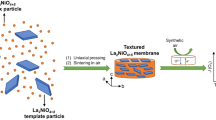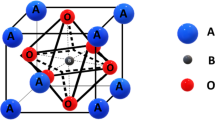Abstract
In this contribution, the binary ceramic system La2CuO4-LaFeO3 is investigated for resistive oxygen sensor applications. The temperature-independent characteristics that are observed for copper contents of 30% or higher are of particular interest. In order to correlate sensor characteristics and material composition, an initial model describing the complex two-phase system is proposed. It is based on the so-called generalized effective media theory (GEMT), a useful tool for describing bi-phase composites. The fitting procedure allows to predict the actual sensor characteristics determined by the experiments.
Similar content being viewed by others
References
H. Wiedenmann, G. Hötzel, H. Neumann, J. Riegel, F. Stanglmeier, and H. Weyl, Exhaust Gas Sensors, in Automotive Electronics Handbook, 2nd edition, R. Jurgen(Ed.), Mc Graw-Hill, New York, 6.1–6.25 (1999).
A. Takami, “Development of titania heated exhaust-gas oxygen sensor,” Ceram. Bull., 67, 1956–1960 (1988).
J. Gerblinger, M. Hauser, and H. Meixner, “Electric and kinetic properties of screen-printed strontium titanate films at high temperatures,” J. Am. Ceram. Soc., 78, 1451–1456 (1995).
N. Izu, W. Shin, I. Matsubara, and N. Murayama, “The effects of the particle size and crystallite size on the response time for resistive oxygen gas sensor using cerium oxide thick film,” Sens. Actuators B, 94, 222–227 (2003).
N. Izu, W. Shin, and N. Murayama, “Fast response of resistive-type oxygen gas sensors based on nano-sized ceria powder,” Sens. Actuators B, 93, 449–453 (2003).
J. Gerblinger, H. Meixner, and P. Kleinschmidt, “Rapid, temperature-compensated sensor, in particular for oxygen and automobile exhaust fumes,” WO 90/03569 (1990).
J. Gerblinger and H. Meixner, “Device for determining the partial pressure of gases in a gas mixture,” European Patent Application EP 563613 A2 (1993).
N. Izu, W. Shin, I. Matsubara, and N. Murayama, “Small temperature-dependent resistive oxygen gas sensor using Ce0.9Y0.1O2-δ as a new temperature compensating material,” Sens. Actuators B, 101, 381–386 (2004).
P. Moseley and D. Williams, “Gas sensors based on oxides of early transition metals,” Polyhedron, 8, 1615–1618 (1989).
R. Moos, W. Menesklou, H. Schreiner, and K.H. Härdtl, “Materials for temperature independent resistive oxygen sensors for combustion exhaust gas control,” Sens. Actuators B, 67, 178–183 (2000).
R. Moos, F. Rettig, A. Hürland, and C. Plog, “Temperature-independent resistive oxygen exhaust gas sensors for lean-burn engines in thick-film technology,” Sens. Actuators B, 93, 42–49 (2003).
R. Blase, K. Härdtl, U. Schönauer, “Oxygen Sensor based on non-doped cuprate,” United States Patent Specification, US 5,792,666 (1997).
R. Blase and K. Härdtl, “Schneller Sauerstoffsensor zur Regelung von Verbrennungsvorgängen” (Fast Oxygen Sensor for Combustion Control), in: VDI-Berichte 1255, VDI-Verlag Düsseldorf, Proceedings of “Sensoren und Messysteme”, Bad Nauheim, Germany, 11–13 March 1996, 137–142 (1996).
A. Krug, “(La,Sr)FeO3—Elektrische Eigenschaften und Sensoranwendungen ((La,Sr)FeO3-Electrical properties and sensor applications),” Ph.D. thesis, Universität Fridericiana Karlsruhe, Karlsruhe, Germany, (1994).
R. Moos and F. Rettig, “Resistiver Sauerstoffsensor (Resistive Oxygen Sensor),” German Patent Specification, DE10114645C1 (2003).
F. Rettig, R. Moos, and C. Plog, “Novel temperature independent resistive oxygen sensor without sulfur instability for combustion engine exhaust,” Sensor 2003 Proceedings, Nürnberg, Germany, 13–15 May 2003, 277–282 (2003).
F. Rettig, R. Moos, and C. Plog, “Sulfur adsorber for thick-film exhaust gas sensors,” Sens. Actuators B, 93, 36–41 (2003).
F. Rettig, R. Moos, and C. Plog, “Poisoning of temperature independent resistive oxygen sensors by sulfur dioxide,” J. Electroceram., 13, 733–738 (2004).
K. Sahner, R. Moos, N. Izu, W. Shin, and N. Murayama, “Resistive temperature-independent oxygen sensors: a comparative study,” Sens. Actuators B, 113, 112–119 (2006).
K. Sahner, R. Moos, M. Matam, J. Tunney, and M. Post, “Hydrocarbon sensing with thick and thin film p-type conducting perovskite materials,” Sens. Actuators B, 108, 102–112 (2005).
R. Landauer, Electrical Conductivity in Inhomogeneous Media(Edited by), D. T. J.C. Garland, American Institute of Physics, New York, 2–45 (1978).
D.S. McLachlan, “An equation for the conductivity of binary mixtures with anisotropic grain structures,” J. Phys. C: Solid State Phys., 20, 865–877 (1987).
R.H. Cruz-Estrada and M.J. Folkes, “Structure formation and modelling of the electrical conductivity in SBS-polyaniline blends. Part II Generalized effective media theories approach, Journal of Materials Science Letters,” 21, 1431–1434 (2002).
D.S. McLachlan, “Measurement and analysis of a model dual-conductivity medium using a generalised effective-medium-theory,” J. Phys. C: Solid State Phys., 21, 1521–1532 (1988).
R.H. Cruz-Estrada and M.J. Folkes, “Structure formation and modelling of the electrical conductivity in SBS-polyaniline blends. Part I Percolation theory approach,” Journal of Materials Science Letters, 21, 1427–1429 (2002).
D.S. McLachlan, M. Blaszkiewicz, and R.E. Newnham, “Electrical resistivity of composites,” J. Am. Ceram. Soc., 73, 2187–2203 (1990)
Author information
Authors and Affiliations
Corresponding author
Rights and permissions
About this article
Cite this article
Sahner, K., Straub, J. & Moos, R. Cuprate-ferrate compositions for temperature independent resistive oxygen sensors. J Electroceram 16, 179–186 (2006). https://doi.org/10.1007/s10832-006-6203-x
Received:
Revised:
Accepted:
Issue Date:
DOI: https://doi.org/10.1007/s10832-006-6203-x




